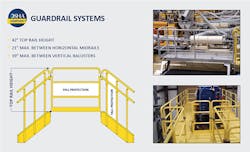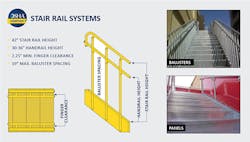OSHA-Compliant Fall Protection for Stairs and Platforms
OSHA requires employers to provide protection for employees from falls and falling objects. This requirement includes the unprotected edges and sides of walking-working surfaces that are four feet or more above a lower level; stairs with more than three treads and four risers; alternating tread stairs and other non-standard stairs; and fixed ladders. Guardrail systems, stair rail systems, and handrails must meet the criteria outlined in OSHA standard 1910.29 to comply with the fall protection requirement.
Guardrail systems
Installing compliant guardrail systems on platforms and working surfaces greater than four feet in height meets the OSHA requirement for fall protection. The guardrail system should be 42 inches (plus or minus three inches) in height from the walking-working surface. The system should include horizontal mid-rails no more than 21” apart and vertical balusters no more than 19 inches apart. The rails of the system must have a smooth surface with diameter of at least .25” and be capable of withstanding the specified measures of force. The ends of the rails cannot extend past the terminal posts except if the overhang does not pose a projection hazard.
Alternatively, a fully closed system with screens or mesh that extend from the lower surface to the top rail are allowed. Guardrail systems that exceed 45 inches in height are compliant if the openings are less than 19 inches and they meet the other requirements.
Stair rail systems
Stairs greater than 44 inches and less than 88 inches in width are required to have compliant stair rail systems with handrails on each side to meet the requirement for fall protection. Stairs greater than 88 inches in width must also include an intermediate handrail in the center of the stair.
Handrails must be between 30 and 36 inches measured from the leading edge of the stair tread to the top surface of the handrail. The handrails must be smooth-surfaced with a shape and dimension that allows them to be grasped firmly and provide a minimum finger clearance of 2.25 inches.
For stairs installed after January 17, 2017, the stair rail systems on open sides must meet the same requirements as guardrail systems. The height requirement of 42 inches for guardrail systems means that the top rail cannot serve as the handrail; the stair rail system must include a separate handrail that meets the specified handrail criteria.
These specifications only cover the criteria for fall protection on stairs. The additional OSHA requirements for stairs are outlined in standard 1910.25.
Fall protection requirements for non-standard stairs
OSHA classifies alternating tread stairs as non-standard stairs and states they are approved for use in applications where it is not feasible to install standard stairs. For applications with space restrictions, installing alternating tread stairs with handrails on each side fulfills the fall protection requirement. In contrast, installing fixed ladders results in additional requirements of fall arrest/ladder safety systems and worker training.
Take the guesswork out of fall protection compliance
Lapeyre Stair’s entire industrial product line is designed specifically to meet the current OSHA requirements for fall protection. Go to www.lapeyrestair.com to learn more, get a quote, and buy online.
About the Author
Lapeyre Stair
More than 85,000 Lapeyre Stair alternating tread stairs are in use around the world today, allowing workers to easily and safely access crossovers, catwalks, and other tight spots that do not permit the use of conventional staircases.
At the company's headquarters outside of New Orleans, Louisiana, alternating tread stairs and traditional steel stairs are manufactured to meet specific height and building code requirements. A variety of options and additional products integrate to create complete, custom stair systems design for each, individual customer's specifications.
Alternating tread stairs can be ordered online and ship within 15 business days. Pre-engineered steel stairs are designed upon approval and ship directly to the project site, ready for installation.
As a dedicated stair manufacturer, Lapeyre Stair provides a complete outsource solution that allows customers to focus on higher priority aspects of their projects.


